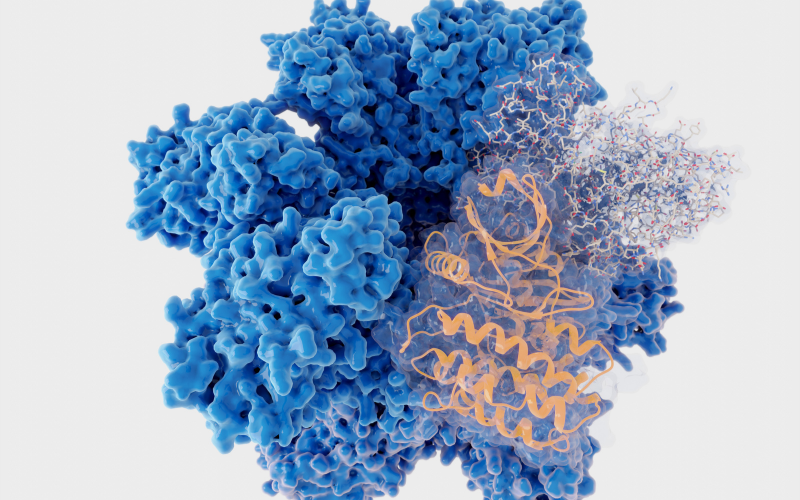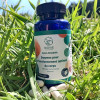Imagine your body as a bustling metropolis of activities. For everything to function harmoniously – from building construction to energy production and waste elimination – you need an army of specialized and incredibly efficient workers. In our body, these miracle workers are the enzymes. Without them, life as we know it would simply be impossible. Every second, millions of chemical reactions occur within us, and enzymes are the conductors that make them possible at the necessary speed.
At Biovie, we know how essential it is to understand the fundamental mechanisms of our body to take care of it. That's why today we invite you to dive into the heart of biology to discover the fascinating world of enzymes: what they are, how they work, the role of enzymes and why they are so vital for our health and well-being. Hold on tight, the journey to the center of our cells begins now!
What exactly is an enzyme?
Simply put, an enzyme is a protein (with a few exceptions) that acts as a biological catalyst. Its role as a catalyst is to speed up a chemical reaction without itself being modified or consumed at the end of the reaction. Think of a match that ignites a wood fire: the match triggers the combustion (the reaction), but it is not the match that burns for hours.
In our body, many essential chemical reactions would be far too slow to sustain life if they had to occur on their own. Necessary enzymes intervene to lower what is called "activation energy" – the minimum amount of energy required to start a reaction. By doing so, they allow these vital reactions to occur thousands, even millions of times faster.
Every cell in our body depends on specific enzymes to perform its tasks. They are the true engines of cellular activity, orchestrating metabolism, repair, communication, and many other fundamental processes.

The mechanism of action: a story of lock and key
How does an enzyme manage to speed up a specific reaction without making mistakes? The answer lies in its unique three-dimensional structure, particularly in a small region called the active site.
- The substrate: This is the molecule on which the enzyme will act. Each enzyme is designed to recognize a very specific type of substrate, much like a key (the substrate) can only open one lock (the enzyme). This targeted recognition is based on the specificity of enzymes, also known as enzymatic specificity, which ensures that each chemical reaction occurs precisely, without any possible confusion between substrates.
- The active site: This is a sort of "pocket" or "crevice" on the surface of the enzyme, whose shape and chemical properties are perfectly complementary to those of the substrate molecules.
- The enzyme-substrate complex: When the substrate meets the appropriate enzyme, it binds to the active site. This binding is not rigid; the enzyme can slightly adjust its shape to "fit" the substrate perfectly (sometimes referred to as the "induced fit" model).
- Catalysis: Once the substrate is bound, the enzyme facilitates its chemical transformation. It can help break bonds, form new ones, or rearrange the atoms of the substrate.
- The release of products: Once the transformation is complete, the new molecules (the products) no longer fit perfectly in the active site and are released.
- The intact enzyme: The enzyme, on the other hand, returns to its original shape, ready to accommodate a new substrate. It has not been altered by the reaction and can start the cycle over and over again.
This process is incredibly efficient and specific. The enzyme catalyzes reactions with remarkable efficiency: depending on its nature, a single molecule can transform hundreds to several million substrates each second. This rapid performance is what makes enzymes indispensable for sustaining life — without them, biochemical reactions would be far too slow for our bodies to function. Each enzyme therefore has a well-defined function: an enzyme that breaks down sugars will not affect fats, and vice versa.
The major families of enzymes and their roles
Enzymes can be classified into several categories, but two major groups are particularly important for understanding their overall role: digestive enzymes and metabolic enzymes.
Digestive enzymes: the nutrient preparers
As their name suggests, each digestive enzyme is responsible for the digestion of the food we eat. Their goal is to break down large complex molecules (proteins, carbohydrates, lipids) into smaller, simpler molecules that our body can absorb.
- Enzymes from raw foods: When we consume raw foods, such as fresh fruits and vegetables, they contain their own enzymes. According to some approaches, the heat and moisture present in our mouth could activate these exogenous enzymes (coming from outside). Once active, the action of the enzymes begins at the very first stages of digestion: they partially predigest the food, thus easing the subsequent work of our own digestive system.
- Endogenous enzymes (produced by our body): Our body itself produces a range of powerful digestive enzymes at different locations in the digestive tract:
- Amylase (saliva, pancreas): Secreted by the salivary glands, this enzyme acts during chewing by initiating the breakdown of starches (complex carbohydrates) into simpler sugars, thus facilitating the first step of digestion in the mouth.
- Pepsin (stomach): In the highly acidic environment of the stomach, it begins to break down long protein chains.
- Trypsin, Chymotrypsin (pancreas -> intestine): Continue the breakdown of proteins in the small intestine.
- Lipase (pancreas -> intestine): Breaks down fats (lipids) into fatty acids and glycerol.
- Lactase, Sucrase, Maltase (intestinal wall): Break down double sugars (lactose, sucrose, maltose) into simple sugars (glucose, fructose, galactose).
Thanks to the concerted action of these enzymes, the human body is capable of transforming food into nutrients: large molecules become small enough (amino acids, simple sugars, fatty acids, vitamins, minerals) to pass through the wall of the small intestine, notably via the intestinal villi, and enter the bloodstream.
Metabolic enzymes: the builders and managers of the body
Once the digested nutrients have reached the blood, another army of enzymes takes over: the metabolic enzymes. These operate inside our cells, in the blood, and in all our tissues. They are the true architects and managers of our body.
Their role is incredibly varied:
- Construction and Repair: They use the 45 known essential nutrients (amino acids, fatty acids, vitamins, minerals...) to build and repair our tissues: muscles, bones, nerves, skin, organs (lungs, glands...).
- Energy Production: Cascades of enzymes are involved in the transformation of glucose and fats into ATP (adenosine triphosphate), the universal energy molecule of our cells (cellular respiration process).
- Synthesis of Complex Molecules: They produce essential molecules like DNA (during cell replication), RNA, hormones, neurotransmitters...
- Detoxification: Specific enzymes, particularly in the liver, transform toxins, medications, and metabolic waste into less harmful and easier-to-eliminate substances.
- Other Functions: Blood clotting, immune defense, nerve signal transmission... These examples illustrate how metabolic enzymes are involved in our vital functions, ensuring the proper functioning of all mechanisms essential to life.
Without these metabolic enzymes, the absorbed nutrients could not be used effectively, and our body could neither function, maintain itself, nor develop.
Factors Influencing Enzyme Activity
Enzymes are efficient but also sensitive to their environment. Like many essential components of living organisms, their proper functioning depends on specific conditions. Several factors can influence their activity:
- Temperature: Each enzyme has an optimal temperature at which it functions best (around 37°C for human enzymes). A temperature that is too low slows down their activity, while a temperature that is too high can irreversibly denature them (they lose their shape and thus their function), like an egg that cooks. This is why a high fever can be dangerous.
- pH (level of acidity): Enzymes also have an optimal pH. For example, pepsin in the stomach works best in a very acidic environment (pH 1.5-2.5), while trypsin in the intestine prefers a more alkaline environment (pH 8). Changes in pH can alter the structure of the enzyme and reduce its effectiveness.
- Substrate concentration: The more substrate available (up to a certain point), the faster the enzyme will work.
- Cofactors and coenzymes: Many enzymes need a non-protein "helper" to function properly. This can be metal ions (magnesium, zinc, iron...) called cofactors, or complex organic molecules, often derived from vitamins (notably B vitamins), called coenzymes. This is one of the reasons why a balanced diet, rich in vitamins and minerals, is crucial for good enzymatic function.
- Inhibitors: Some substances can block or slow down enzyme activity. Some medications act as enzyme inhibitors to treat diseases. Toxins or heavy metals can also inhibit vital enzymes.
The importance of enzymes for our health
As you can see, enzymes are at the heart of our health. An enzyme deficiency or malfunction can have significant consequences. For example:
- Lactose intolerance: Due to a deficiency in lactase, the enzyme that digests milk sugar.
- Phenylketonuria: A rare genetic disorder where an enzyme necessary to metabolize the amino acid phenylalanine is absent or deficient.
- Chronic digestive disorders: They can be a sign of a disruption in the digestive process, often linked to insufficient production of digestive enzymes, particularly pancreatic enzymes. This enzyme deficiency prevents the proper breakdown of nutrients in the intestine, which can cause abdominal pain, bloating, or a feeling of heaviness after meals.
Supporting optimal enzyme function involves several aspects of a healthy lifestyle:
- A varied and balanced diet: To provide basic nutrients (substrates) and cofactors (vitamins, minerals) needed.
- The consumption of raw and fresh foods: As mentioned, they bring their own enzymes and are often rich in vitamin and mineral cofactors.
- Good hydration: Water is essential for the structure and function of enzymes.
- Stress management: Chronic stress can disrupt hormonal balance and indirectly affect enzymatic function.
- Avoiding excesses: Alcohol, tobacco, ultra-processed foods can overload enzymatic systems, especially those involved in detoxification.
Conclusion
Let's cherish our enzymes! Enzymes are much more than simple chemical molecules. They play a central role in cell function, orchestrating thousands of reactions essential to life. From breaking down our last meal to producing energy, to repairing our tissues, they work discreetly but tirelessly at every moment of our existence.
Understanding the essential role of these biological catalysts reminds us of the incredible complexity and efficiency of our body. Taking care of our body, especially through a living and balanced diet like the one we advocate at Biovie, also means taking care of our precious enzymes and allowing them to continue their indispensable work for our vitality and daily well-being. They are the true silent heroines of our health.
> We strongly encourage you to visit the section of our store dedicated to the enzyme complexes we offer in partnership with ZencleanZ, a company expert in the use of enzymes.
FAQ - Frequently Asked Questions about Enzymes
1- What exactly is an enzyme?
An enzyme is primarily a protein that acts as a biological catalyst. Its role is to significantly accelerate the chemical reactions necessary for life in our body, without being modified itself at the end of the reaction. Each enzyme is specific to a reaction or a type of molecule (substrate).
2- What is the main role of digestive enzymes?
Digestive enzymes break down large food molecules (proteins, carbohydrates, lipids) into smaller nutrients (amino acids, simple sugars, fatty acids). Among the benefits of enzymes, this ability to make nutrients assimilable is fundamental: it allows their absorption by the intestine and their passage into the bloodstream, where they can nourish our cells. These enzymes are involved at every stage of digestion, from the mouth to the intestine.
3- Where do metabolic enzymes act and what do they do?
Metabolic enzymes primarily act inside our cells, in the blood, and tissues. They use absorbed nutrients to build and repair tissues (muscles, bones, nerves), produce energy (ATP), synthesize vital molecules (DNA, hormones), and detoxify the body. They are fundamental for all cellular functions.
4- Why are enzymes said to be specific?
Enzyme specificity means that each enzyme is designed to interact with a particular type of molecule (its substrate) and catalyze a specific chemical reaction. This is due to the enzyme's unique three-dimensional shape, particularly its active site, which fits like a key in a lock with its substrate.
5- How can our diet influence our enzymes?
Diet influences our enzymes in several ways. It provides the "building blocks" (substrates) on which enzymes act. It also supplies essential vitamins and minerals that act as cofactors or coenzymes, indispensable for the proper functioning of many enzymes. Additionally, raw foods contain their own enzymes that could participate in initial digestion.
References
- Berg, J.M., Tymoczko, J.L., & Stryer, L. (2012). Biochemistry (7th ed.). W.H. Freeman and Company.
- Nelson, D.L., & Cox, M.M. (2017). Lehninger Principles of Biochemistry (7th ed.). W.H. Freeman and Company.
- Voet, D., & Voet, J.G. (2011). Biochemistry (4th ed.). John Wiley & Sons.
(In French, this information can be found in biochemistry or physiology textbooks)
- Lodish, H., Berk, A., Kaiser, C.A., Krieger, M., Bretscher, A., Ploegh, H., Amon, A., & Scott, M.P. (2014). Molecular Biology of the Cell (French adaptation by C.D. Dijkstra et al., 6th ed.). De Boeck Supérieur.
- Costanzo, L.S. (2018). Physiology (French adaptation by J-P. Montani, 6th ed.). Elsevier Masson.





















